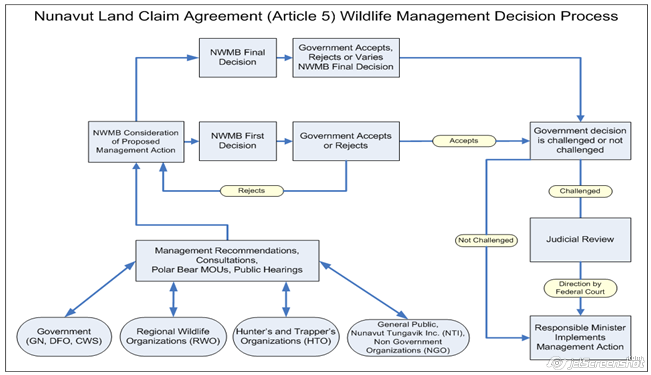NWMB Co-Management
During the negotiation of the Nunavut Agreement, the parties agreed that the NWMB’s role in the decision-making process for wildlife management would move beyond the pre-Nunavut Agreement paradigm of decision-making, wherein Inuit were relegated, at best, to the margins of the decision-making process. Instead, the concept of decision-making was expanded, to place this administrative body at the heart of the process, by including it in actual decisions made with respect to wildlife in Nunavut.
However, an expanded and more inclusive decision-making model is not the only feature of co-management under the Nunavut Agreement. In fact, the co-management process with respect to wildlife can be described as a system of partnerships, in which the partners work cooperatively to assist the NWMB to make particular decisions, to conduct and commission research, and to provide approvals, advice, recommendations and information. In addition, it is Government that implements and enforces NWMB decisions, once they are made.
In this process, there is a partnership between the NWMB and Government, between the NWMB and Inuit, and between Government and Inuit. The keys to success in such a process are communication and cooperation. However, it is important to emphasize that co-management decision-making takes place solely within the NWMB.

Other Institutions of Public Government (IPGs):
In addition to the NWMB, the Nunavut Agreement created other Boards to manage the land and resources in the Nunavut Settlement Area which include the Nunavut Planning Commission (NPC), the Nunavut Impact Review Board (NIRB), the Nunavut Water Board (NWB) and the Nunavut Surface Rights Tribunal (NSRT). The NWMB, NPC, NIRB and NWB, may act together as the Nunavut Marine Council when necessary to address issues of common concern relating to the marine areas of Nunavut.
Nunavut Planning Commission (NPC);
The Nunavut Planning Commission is an Institution of Public Government established under Article 11 of the Nunavut Agreement, Land Use Planning. As per s. 11.4.1 of the Nunavut Agreement, the NPC was established with the major responsibilities to:
- establish broad planning policies, objectives and goals for the Nunavut Settlement Area in conjunction with Government;
- develop, consistent with other provisions of this Article, land use plans that guide and direct resource use and development in the Nunavut Settlement Area; and
- generally, fulfill the objectives of the Agreement in the manner described, and in accordance with the general principles mentioned in Section 11.2.1, as well as such additional functions as may be agreed upon from time to time by Government and the DIO (Designated Inuit Organization).
Contact information and more information on NPC can be found at www.nunavut.ca.
Nunavut Impact Review Board (NIRB):
The Nunavut Impact Review Board is an Institution of Public Government established as an institution of public government under Article 12 of the Nunavut Agreement. As per s. 12.2.2 of the Nunavut Agreement the primary functions of NIRB shall be:
- to screen project proposals in order to determine whether or not a review if required;
- to gauge and define the extent of the regional impacts of a project, such definition to be taken into account by the Minister in making his or her determination as to the regional interest;
- to review the ecosystemic and socio-economic impacts of project proposals;
- to determine, on the basis of its review, whether project proposals should proceed, and if so, under what terms and conditions, and then report its determination to the Minister; in addition, NIRB’s determination with respect to socio-economic impacts unrelated to ecosystemic impacts shall be treated as recommendations to the Minister; and
- to monitor projects in accordance with the provision of Part 7.
Contact information and more information on NIRB can be found at www.nirb.ca
Nunavut Water Board (NWB):
The Nunavut Water Board was established as an institution of public government under s. 13.2.1 of the Nunavut Agreement. NWB has the responsibilities and powers over the regulation, use and management of water in the Nunavut Settlement Area.
Contact information and more information on NWB can be found at www.nwb-oen.ca
Inuit Organizations
The Inuit of Nunavut are part of the co-management partnership and are represented by Nunavut Tunngavik Incorporated (NTI). The Regional Inuit Associations nominate members to the NWMB. We also work with the national Inuit association, Inuit Tapiriit Kanatami on some issues.
For more information on NTI or the Regional Inuit Associations, please visit www.tunngavik.com/
For more information on the Inuit Tapiriit Kanatami, please visit www.itk.ca
Nunavut Inuit Wildlife Secretariat (NIWS):
The NWMB coordinates its activities with Nunavut's 27 community-based Hunters and Trappers Organizations (HTOs), and three Regional Wildlife Organizations (RWOs), which together work collaboratively with the NIWS. These organizations oversee harvesting at the local and regional levels, while the NWMB oversees wildlife management throughout the Nunavut Settlement Area. We also provide funding to these groups.
For information on these organizations, please visit www.niws.ca
Government
The NWMB takes its direction from the Nunavut Agreement and carries out its duties as an independent body. We are not under the direction of other branches of public government, although we work cooperatively with them on most issues concerning the management of Nunavut’s wildlife.
Territorial:
- Department of Environment, Wildlife Management – env.gov.nu.ca/programareas/wildlife
- Department of Environment, Fisheries and Sealing – env.gov.nu.ca/programareas/fisheriesandsealing
- Department of Environment, Parks and Special Places - env.gov.nu.ca/programareas/parksandspecialplaces
- Department of Environment, Environmental Protection - env.gov.nu.ca/programareas/environmentprotection
Federal:
- Aboriginal Affairs and Northern Development Canada – www.aadnc-aandc.gc.ca
- Fisheries and Oceans Canada– www.dfo-mpo.gc.ca
- Environment Canada – www.ec.gc.ca
- Parks Canada - www.pc.gc.ca
- Natural Resources Canada - www.nrcan.gc.ca
Other Canadian Wildlife Management Boards:
Naturally; animals, birds, plants and fish don't recognize political boundaries, so it's important for the NWMB to work with other groups outside Nunavut on matters of common interest. Among these groups are:
Northwest Territories
- Sahtu Renewable Resources Board - www.srrb.nt.ca
- Fisheries Joint Management Committee - http://www.fjmc.ca/
- Inuvialuit Game Council - http://www.jointsecretariat.ca/igc.html
- Wek'eezhii Renewable Resources Board - http://www.wrrb.ca/
- Wildlife Management Advisory Council - http://www.wmacns.ca/
- Gwich'in Renewable Resource Board - http://www.grrb.nt.ca/
Yukon
- Yukon Fish and Wildlife Management Board - www.yfwmb.ca
- Quebec - Nunavik Marine Region Wildlife Board - nmrwb.ca/
- Makavik Corporation– www.makivik.org
Newfoundland & Labrador
- Torngat Wildlife and Plants Co-Management Board www.torngatsecretariat.ca



